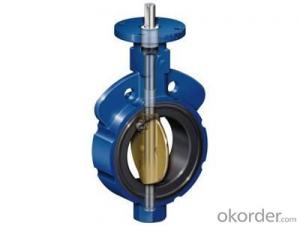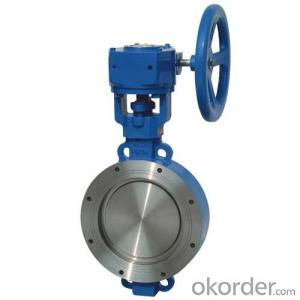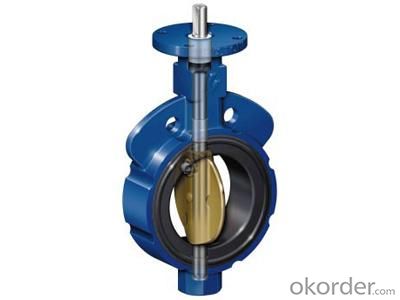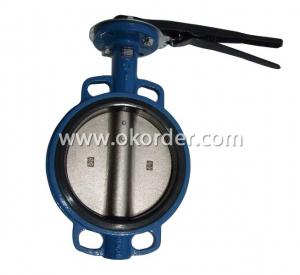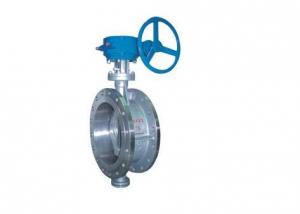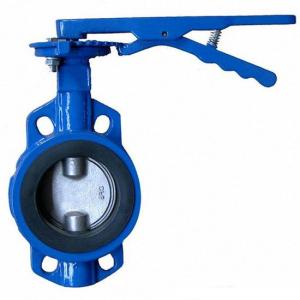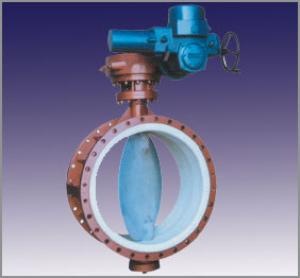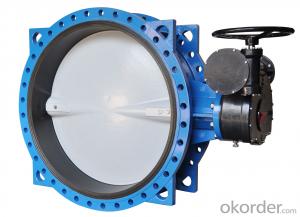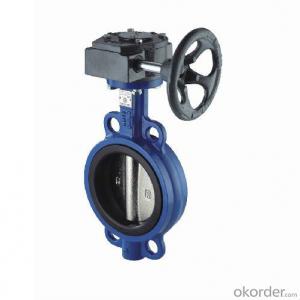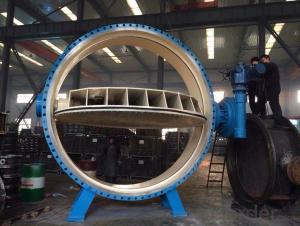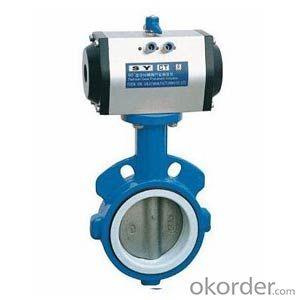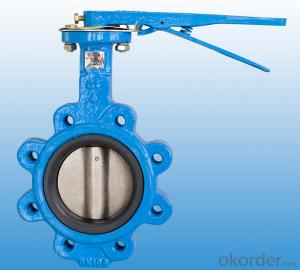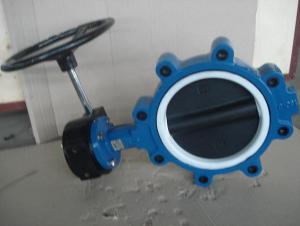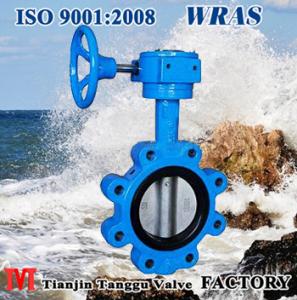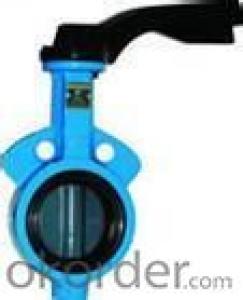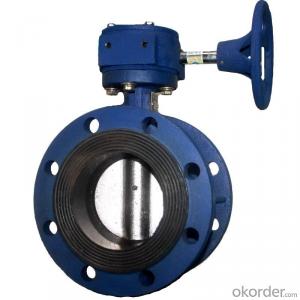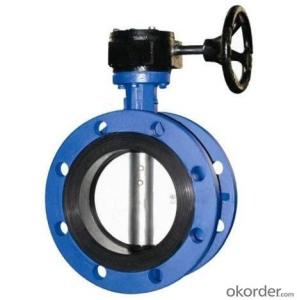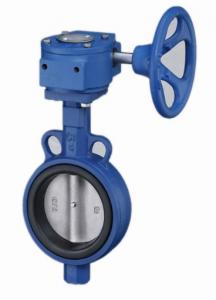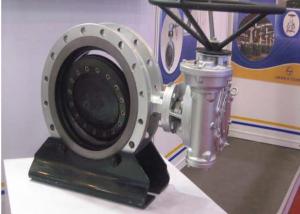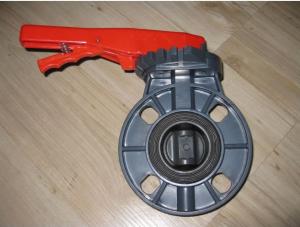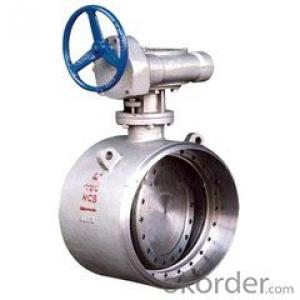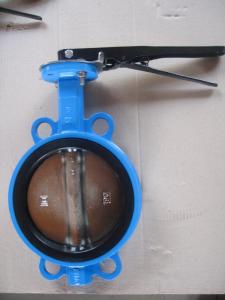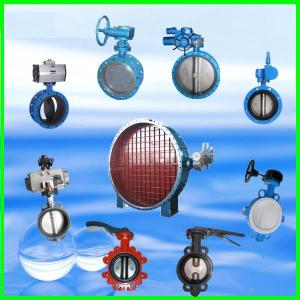Butterfly Valve Central Line Design Lug Type
- Loading Port:
- China main port
- Payment Terms:
- TT OR LC
- Min Order Qty:
- 10 set
- Supply Capability:
- 10000 set/month
OKorder Service Pledge
OKorder Financial Service
You Might Also Like
1. Butterfly Valve Description:
A butterfly valve is a valve which can be used for isolating or regulating flow. The closing mechanism takes the form of a disk. Operation is similar to that of a ball valve, which allows for quick shut off. Butterfly valves are generally favored because they are lower in cost to other valve designs as well as being lighter in weight, meaning less support is required. The disc is positioned in the center of the pipe, passing through the disc is a rod connected to an actuator on the outside of the valve. Rotating the actuator turns the disc either parallel or perpendicular to the flow. Unlike a ball valve, the disc is always present within the flow, therefore a pressure drop is always induced in the flow, regardless of valve position.
2.Main Features of the Butterfly Valve
(1) 90° movement for full open/close position.
(2) Excellent control characteristics.Tight shut-off even after innumerable operations.
(3) Installation cost considerably reduced because of very low weight and compact design.
(4) Longer life and reliable service with minimum component wear.
(5) Renewable seats. No supplementary gasket required with the adjacent pipework.
(6) Body & Stem totally protected from service fluid.
3. Butterfly Valve Images:
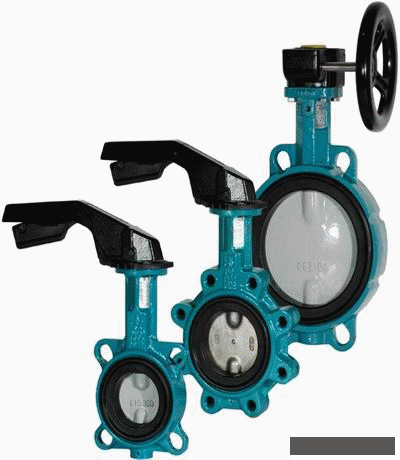
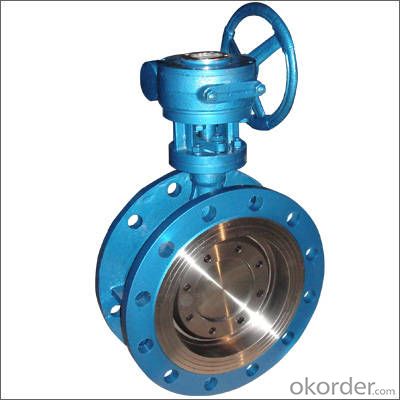
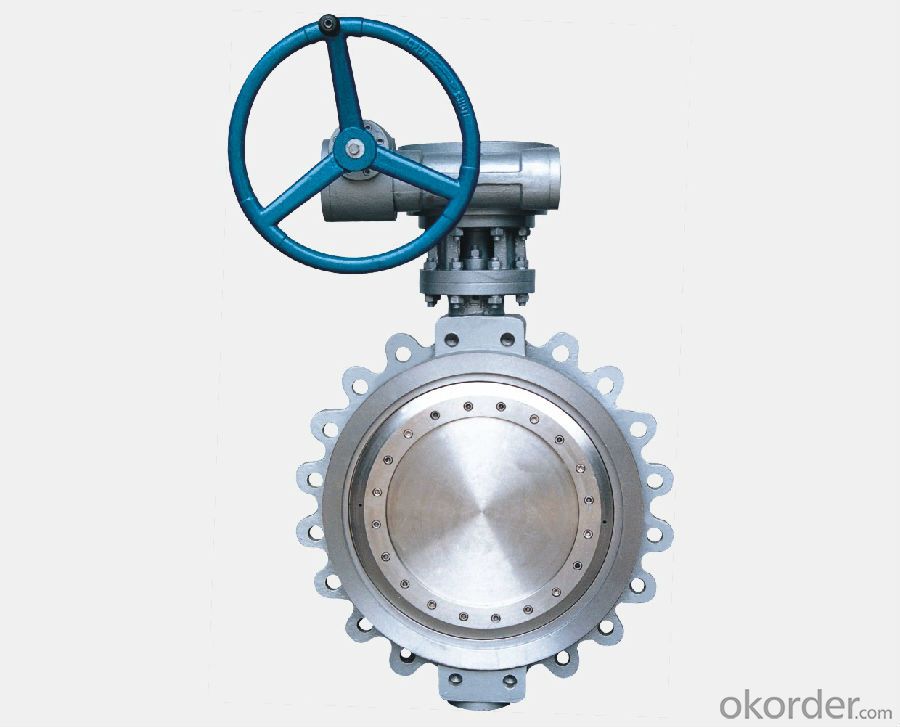
4.Butterfly Valve Specification:
BODY | DISC | STEM | SEAT | BUSHING | |
MATERIAL | WORKING PRESSURE | ||||
CAST IRON | DUCTILE IRON WITH NICKEL PLATED | CARBON STEEL | NR | -20-+85 | LUBRIZED BRONZE |
DUCTILE IRON | ALUMINUM BRONZE | STAINLESS | HYPALON | -18-+135 INSTANTANEOUS -18-+149 | PTFE |
ALUMINUM | STAINLESS STEEL | EPDM | -45-+135 INSTANTANEOUS -50-+150 | ||
CARBON STEEL | CARBON | NEOPRENE | -7-+193 INSTANTANEOUS -7-+107 | ||
STAINLESS STEEL | NBR | -12-+82 INSTANTANEOUS -12-+93 | |||
WEAR-RESISTANT RUBBER | -10-+50 | ||||
VITON | -23-+150 | ||||
HEAT-RESISTANT RUBBER | -20-+150 | ||||
PTFE | +10-+150 | ||||
5.FAQ
1. What is manual wafer butterfly valve?
Wafer style is the more common of the two and is less expensive than the lug style. The wafer style butterfly valve is just about the standard. It ís so common that no one even bothers to use the word "wafer" when ordering a butterfly valve. It is taken for granted that if a butterfly valve is ordered, a wafer style will be received.
2. How about the Installation of the Wafer Style Butterfly Valve?
Butterfly valves are installed by inserting the valve between two flanges using bolts or studs and nuts to hold it all together. This type of installation, of course, makes it impossible to disconnect just one side of the piping system from the valve. That benefit is received using the lug style valve.
3. What is the working principle of manual wafer butterfly valve?
A butterfly valve is from a family of valves called quarter-turn valves. In operation, the valve is fully open or closed when the disc is rotated a quarter turn. The "butterfly" is a metal disc mounted on a rod. When the valve is closed, the disc is turned so that it completely blocks off the passageway. When the valve is fully open, the disc is rotated a quarter turn so that it allows an almost unrestricted passage of the fluid. The valve may also be opened incrementally to throttle flow.
- Q: Why use special flanges for butterfly valves?
- Butterfly valve to use special flange, butterfly valve itself is because of the structure of the decision, the butterfly valve to clip type connection, this pair of clamps is a special flange.Also known as butterfly valve, control valve has a simple structure, can be used for low pressure pipeline valve switching control is closed parts (disc or disc) is a disk, around the valve axis to achieve the opening and closing a valve, the valve can be used to control the flow of air, water, steam steam, all kinds of corrosive medium, mud, oil, metals and radioactive liquid media and other types of fluid. On the pipeline, mainly from cutting and throttling. Butterfly valve headstock is a disc shaped disc, in the valve body around its own axis of rotation, so as to achieve the purpose of opening or closing or regulation.
- Q: i have a slightly small mitral valve leak in my heart. my cardiologist say nothing to worry about, but i am not sure. can some one explain if it would eventually lead to some complications?
- I have Mitral Valve Prolapse, and slight regurgitation. If your cardiologist says not to worry, I wouldn't worry. Mitral Valve prolapse just means you have a slight deformity of the bicuspid valve. It doesn't close correctly. It's not a disease, or anything like that, just a slight deformity. The symptoms are annoying. You may or may not have palpitations, slight sharp chest pain sometimes, dizziness, fatigue, and anxiety from it. You must have it checked yearly to make sure it's not progressing. I have had it since I was born, and now I am 28, and it has not progressed at all. MILLIONS of people are walking around with it, and don't even know it. It's not really a big deal. However, it does have the potential to worsen and you may or may not need a new valve. But that normally happens when you're older, in your 50's or up. Don't worry about it.
- Q: I am confused as to the answer of this question. Please help.Indicate the status of the mitral, tricuspid and semilunar valves (whether they are open or closd) during the various phases of the cardiac cycle. Discuss the pressure in each of the relevant chambers or blood vessels during the phases with reference to the opening or closing of the valves.
- A heartbeat is a two-part pumping action that takes about a second. As blood collects in the upper chambers (the right and left atria), the heart's natural pacemaker (the SA node) sends out an electrical signal that causes the atria to contract. This contraction pushes blood through the tricuspid and mitral valves into the resting lower chambers (the right and left ventricles). This part of the two-part pumping phase (the longer of the two) is called diastole. The second part of the pumping phase begins when the ventricles are full of blood. The electrical signals from the SA node travel along a pathway of cells to the ventricles, causing them to contract. This is called systole. As the tricuspid and mitral valves shut tight to prevent a back flow of blood, the pulmonary and aortic valves are pushed open. While blood is pushed from the right ventricle into the lungs to pick up oxygen, oxygen-rich blood flows from the left ventricle to the heart and other parts of the body. After blood moves into the pulmonary artery and the aorta, the ventricles relax, and the pulmonary and aortic valves close. The lower pressure in the ventricles causes the tricuspid and mitral valves to open, and the cycle begins again. This series of contractions is repeated over and over again, increasing during times of exertion and decreasing while you are at rest. The heart normally beats about 60 to 80 times a minute when you are at rest, but this can vary. As you get older, your resting heart rate rises. Also, it is usually lower in people who are physically fit.
- Q: The difference between butterfly valve and gate valve
- Its varieties and quantities are still expanding, and the development of high temperature, high pressure, large caliber, high sealing, long life, excellent regulation, as well as multi-function development of one valve. Its reliability and other performance indicators have reached a high level. Disadvantages, there is a certain resistance to the medium. Gate valves are more used in steam pipes and large diameter water supply pipelines, because of the general requirements of fluid resistance is small, the use of gate valve. Valve is hand wheel rotation, stem upward movement. Flow is not the same, the gate valve requires full open. Need a higher installation space, the valve sealing surface has a certain self sealing capacity, its spool by the media pressure closely with the valve seat sealing surface contact, to achieve tight leakage.
- Q: How can one - way sealed butterfly valves and two-way sealed butterfly valves be distinguished?
- The difference between one way butterfly valve and two way butterfly valve:One way hard sealing butterfly valve:The butterfly's body usually has an arrow to indicate the direction of media flow, the butterfly valve plate in front of the closed, must face the flow of media, so we should pay attention to the medium flow direction when installing a one-way valve.
- Q: What is an electric two position butterfly valve?
- It's an electric valveProduct brief:??Electric double position butterfly valve, this product is connected with flange type, clip type. Material: cast iron, carbon steel, stainless steel, 304/316Product overview???Electric double position butterfly valve (soft seal) is suitable for temperature less than 200 DEG C, adjust the flux and closure of the role of the medium nominal pressure is less than 1.6MPa of food, medicine, chemical, petroleum, electric power, textile, papermaking, water supply and drainage, gas pipeline. ?main features1 reasonable and novel design, unique structure, light weight, rapid opening and closing.2 operating torque is small, easy to operate, saving smart.3 can be installed in any position, convenient maintenance.4 seals can be replaced, reliable sealing performance to achieve two-way seal zero leakage.5 sealing material aging resistance, corrosion resistance, long service life etc..Electric double position butterfly valve adopts standardDesign standard: GB/T12238-1889Flange size: GB/T9113.1-2000; GB/T9115.1-2000; JB78Length: GB/T12221-1889Pressure test: GB/T13927-1992; JB/T9092-1999
- Q: Butterfly valve D71X-10 and butterfly D371X-10 what is the difference?
- One is the turbine drive and the other is with the handle
- Q: oil coming from valve into turbo charger
- The last two answers were wrong. Duramax motors have a Pcv valve. It stands for positive crankcase ventilation and every engine has one that I am aware of and it's to relieve the air pressure built up in the crankcase from the pistons moving up and down. The Pcv allows atmospheric air pressure inside then crankcase. If there is a lot of air pressure coming out of the Pcv you could have bad valve seals or worn piston rings allowing massive amounts of air being forced into the crank case. The Pcv valve on 2003 and older have the Pcv built into the valve cover. It is a box shape cap that has a spring and diaphragm under it. Old question just thought I would clear that up for the 2 people not so mechanically inclined that answered last.
- Q: The difference between the directly buried gate and the flange valve and butterfly valve
- Buried gate also called buried gate valve, valve can be directly buried underground, built without manhole, reduce road excavation area; small well maintained road and beautiful room can reduce the difficulty of construction, reduce project cost. The directly buried soft sealing gate valve is divided into two types: telescopic type and fine fixing type, wherein, the telescopic type is divided into metal type and plastic type. In the process of construction, the telescopic type can be adjusted arbitrarily according to the distance between the buried depth of the valve and the ground, and the micro adjustment can be adjusted on the spot. The directly buried gate valve has the advantages of long-term use, no leakage, no maintenance, etc., and can effectively avoid other people switching the valve and stealing the manhole cover at will.Flange gate valve is connected to the flange gate valve, this connection is the most common way. The flange gate valve is stable and reliable when used in the pipeline, so the flange gate valve is used on the high pressure pipeline.Butterfly valve refers to the closure of parts (valve or butterfly plate) as the disk, around the valve shaft to achieve rotation and closing of a valve, the main cut off on the pipe and throttling role. Butterfly valve headstock is a disc shaped disc, in the valve body around its own axis of rotation, so as to achieve the purpose of opening or closing or regulation. Butterfly valve used in furnace, coal gas, natural gas, liquefied petroleum gas, city gas, hot and cold air, chemical smelting and power generation environmental protection engineering system, conveying a variety of corrosive and non corrosive media pipeline, used to adjust and cut off the media flow.
- Q: What's the difference between an electric two position control valve and an electric butterfly valve?
- With manual control device, once the power failure occurs, you can temporarily manually operated, and will not affect the use.The biggest difference is that the electric double bit butterfly valve can not fine adjustment; and the electric butterfly valve can play a regulating role.
Send your message to us
Butterfly Valve Central Line Design Lug Type
- Loading Port:
- China main port
- Payment Terms:
- TT OR LC
- Min Order Qty:
- 10 set
- Supply Capability:
- 10000 set/month
OKorder Service Pledge
OKorder Financial Service
Similar products
Hot products
Hot Searches
